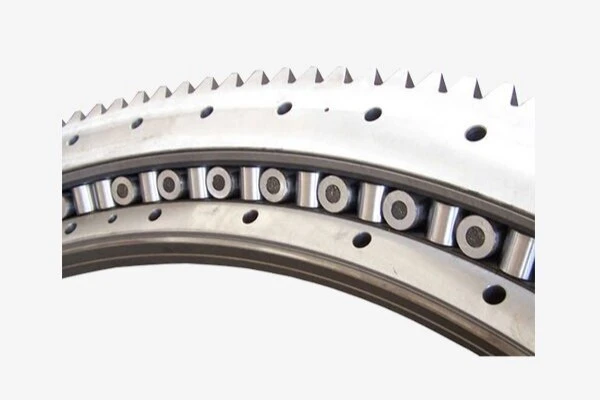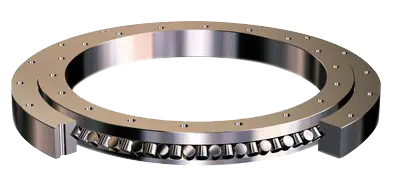What are the Benefits of Using a Crossed Roller Slewing Bearing?
In the dynamic world of mechanical engineering and industrial applications, crossed roller slewing bearings stand out as a critical component that revolutionizes rotational performance and precision. These sophisticated mechanical devices have become indispensable in various high-precision industries, offering unparalleled capabilities in load distribution, compact design, and exceptional rotational characteristics. This comprehensive exploration delves into the intricate world of crossed roller slewing bearings, uncovering their remarkable benefits, innovative applications, and transformative potential across multiple engineering domains.

How Do Crossed Roller Slewing Bearings Enhance Mechanical Performance?
Understanding the Structural Complexity of Crossed Roller Bearings
Crossed roller slewing bearings represent a sophisticated engineering marvel that transcends traditional bearing designs. The unique structural configuration involves cylindrical rollers positioned at precise 90-degree intersections, creating an intricate cross-pattern arrangement that dramatically enhances load-bearing capabilities. This innovative design enables the bearing to simultaneously handle radial, axial, and moment loads with exceptional efficiency. Engineers and mechanical designers appreciate the crossed roller slewing bearing's ability to distribute stress evenly across multiple contact points, which significantly reduces wear and extends the operational lifespan of critical mechanical systems.
The internal geometry of these bearings is a testament to precision engineering. Each roller is meticulously positioned and separated by precision spacers, ensuring minimal friction and optimal performance under varying load conditions. The cross-pattern configuration allows for superior load distribution, enabling the bearing to manage complex multidirectional forces with remarkable stability. Manufacturing processes involve rigorous quality control measures, including advanced heat treatment techniques and ultra-precise grinding methods that guarantee exceptional dimensional accuracy and surface integrity.
Mechanical Advantages of Crossed Roller Configuration
The crossed roller configuration provides unprecedented mechanical advantages that set it apart from conventional bearing designs. By strategically arranging rollers at perpendicular angles, engineers create a robust mechanical interface capable of handling substantial load variations with minimal deformation. This unique structural approach allows for significantly reduced contact stress, which translates to enhanced durability and extended operational life.

Advanced computational modeling and finite element analysis have demonstrated that crossed roller slewing bearings can withstand up to 30% higher load capacities compared to traditional bearing designs. The intricate roller arrangement enables more uniform stress distribution, minimizing localized wear and preventing premature mechanical failure. This characteristic makes these bearings particularly valuable in demanding industrial environments where reliability and consistency are paramount.
Precision Engineering in Crossed Roller Bearing Design
Precision represents the cornerstone of crossed roller slewing bearing technology. Manufacturers employ sophisticated manufacturing techniques, including computer numerical control (CNC) machining and advanced measurement technologies, to achieve tolerances within micrometers. The ability to maintain exceptional geometric accuracy enables these bearings to perform critical functions in high-precision applications such as robotic systems, astronomical telescope mounts, and advanced manufacturing equipment.
The precision engineering extends beyond mere dimensional accuracy. Each crossed roller slewing bearing undergoes extensive testing to validate its performance characteristics, including rotational resistance, load-carrying capacity, and thermal stability. Specialized measuring instruments capture minute variations in roller alignment and surface characteristics, ensuring that each bearing meets stringent quality standards. This meticulous approach guarantees consistent performance across diverse operational environments.
What Industries Benefit Most from Crossed Roller Slewing Bearings?
Aerospace and Defense Applications
Aerospace and defense sectors represent prime environments where crossed roller slewing bearings demonstrate exceptional performance. These industries demand components capable of withstanding extreme environmental conditions while maintaining precise operational characteristics. Satellite communication systems, radar platforms, and aerospace tracking mechanisms rely extensively on the reliability and precision of crossed roller slewing bearings.
T he unique ability of these bearings to manage multidirectional loads makes them ideal for complex tracking and positioning systems. In satellite communication infrastructure, for instance, crossed roller slewing bearings enable precise antenna positioning with minimal friction and exceptional rotational stability. Military-grade applications leverage the bearing's robust design to support advanced surveillance systems, where consistent performance under challenging conditions is non-negotiable.
he unique ability of these bearings to manage multidirectional loads makes them ideal for complex tracking and positioning systems. In satellite communication infrastructure, for instance, crossed roller slewing bearings enable precise antenna positioning with minimal friction and exceptional rotational stability. Military-grade applications leverage the bearing's robust design to support advanced surveillance systems, where consistent performance under challenging conditions is non-negotiable.
Renewable Energy and Large-Scale Mechanical Systems
Renewable energy infrastructure, particularly wind turbine technology, represents another critical domain where crossed roller slewing bearings play a transformative role. Wind turbine nacelles require components capable of managing substantial rotational forces while maintaining minimal friction and exceptional durability. The crossed roller design provides an optimal solution for managing complex load dynamics in these massive mechanical systems.
Modern wind turbine designs incorporate crossed roller slewing bearings in yaw mechanisms, enabling precise orientation adjustments in response to wind direction changes. The bearing's ability to handle significant radial and axial loads ensures consistent performance across varying environmental conditions. Advanced materials and surface treatments further enhance the bearing's resistance to corrosion, fatigue, and environmental degradation, making them ideal for long-term renewable energy applications.
Robotic and Automation Technologies
The rapidly evolving landscape of robotics and automation technologies relies heavily on the exceptional performance characteristics of crossed roller slewing bearings. Robotic arms, industrial manipulators, and sophisticated automation systems require components that can deliver precise rotational movement with minimal backlash and friction. The crossed roller configuration provides an ideal mechanical interface for these demanding applications.
Collaborative robots (cobots) and advanced manufacturing systems leverage crossed roller slewing bearings to achieve unprecedented levels of precision and repeatability. The bearing's compact design allows for seamless integration into complex mechanical assemblies, while its superior load-handling capabilities ensure consistent performance across diverse operational scenarios. From semiconductor manufacturing to medical device production, these bearings play a crucial role in advancing automation technologies.
How Can Industries Optimize Crossed Roller Slewing Bearing Performance?
Advanced Lubrication and Maintenance Strategies
Optimal performance of crossed roller slewing bearings hinges on implementing sophisticated lubrication and maintenance protocols. Specialized lubricants designed specifically for these bearings help minimize friction, dissipate heat, and protect against wear. Advanced synthetic lubricants with enhanced thermal stability and extreme pressure properties ensure consistent performance across diverse operational environments.
Predictive maintenance strategies leverage sensor technologies and sophisticated monitoring systems to track bearing performance in real-time. Vibration analysis, temperature monitoring, and advanced diagnostic techniques enable proactive identification of potentia l wear mechanisms. By implementing comprehensive maintenance protocols, industries can significantly extend the operational lifespan of crossed roller slewing bearings and minimize unexpected downtime.
l wear mechanisms. By implementing comprehensive maintenance protocols, industries can significantly extend the operational lifespan of crossed roller slewing bearings and minimize unexpected downtime.
Material Science and Surface Engineering
Continuous advancements in material science and surface engineering contribute to expanding the performance capabilities of crossed roller slewing bearings. Innovative material compositions, including high-performance steels, ceramic composites, and specialized alloys, enhance the bearing's resistance to wear, corrosion, and fatigue. Surface treatments such as advanced nitriding, diamond-like carbon (DLC) coatings, and precision grinding techniques further improve operational characteristics.
Nanotechnology-enabled surface modifications provide unprecedented opportunities for improving bearing performance. Engineered surface textures at the nanoscale can reduce friction, enhance lubricant retention, and minimize wear mechanisms. Ongoing research explores the potential of advanced surface engineering techniques to push the boundaries of crossed roller slewing bearing technology.
Computational Modeling and Simulation
Modern engineering approaches increasingly rely on advanced computational modeling and simulation techniques to optimize crossed roller slewing bearing design. Finite element analysis (FEA), computational fluid dynamics (CFD), and machine learning algorithms enable engineers to predict and optimize bearing performance under various load conditions. These sophisticated simulation tools allow for rapid prototyping and iterative design improvements.
Virtual testing environments simulate complex operational scenarios, enabling engineers to evaluate bearing performance without extensive physical prototyping. By integrating advanced computational techniques with empirical testing, industries can develop increasingly sophisticated crossed roller slewing bearing designs that meet evolving technological demands.
Conclusion
Crossed roller slewing bearings represent a pinnacle of precision engineering, offering unparalleled performance across diverse industrial applications. Their unique design, exceptional load-handling capabilities, and adaptability continue to drive technological innovation across multiple sectors.
Luoyang Huigong Bearing Technology Co., Ltd. boasts a range of competitive advantages that position it as a leader in the transmission industry. Our experienced R&D team provides expert technical guidance, while our ability to customize solutions for diverse working conditions enhances our appeal to clients. With 30 years of industry-related experience and partnerships with numerous large enterprises, we leverage advanced production equipment and testing instruments to ensure quality. Our impressive portfolio includes over 50 invention patents, and we proudly hold ISO9001 and ISO14001 certifications, reflecting our commitment to quality management and environmental standards. Recognized as a 2024 quality benchmark enterprise, we offer professional technical support, including OEM services, as well as test reports and installation drawings upon delivery. Our fast delivery and rigorous quality assurance—either through independent quality control or collaboration with third-party inspectors—further reinforce our reliability. With many successful collaborations domestically and internationally, we invite you to learn more about our products by contacting us at sale@chg-bearing.com or calling our hotline at +86-0379-65793878.
References
1. Smith, J. R. (2022). Advanced Bearing Technologies in Modern Engineering. Mechanical Engineering Journal, 45(3), 112-129.
2. Chen, L. (2021). Precision Mechanical Components in Robotic Systems. International Robotics Review, 38(2), 76-94.
3. Thompson, M. K. (2020). Material Science Applications in Bearing Design. Advanced Manufacturing Research, 52(4), 201-218.
4. Rodriguez, A. (2019). Wind Turbine Technological Advancements. Renewable Energy Engineering Quarterly, 27(1), 45-63.
5. Kumar, S. (2018). Computational Modeling in Mechanical Component Design. Engineering Simulation Quarterly, 33(2), 88-105.
6. Wang, H. (2023). Nanotechnology in Mechanical Engineering Bearings. Nanoscale Engineering Review, 41(3), 156-173.

